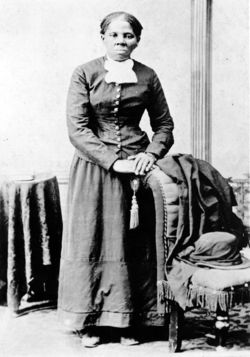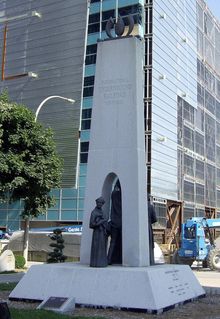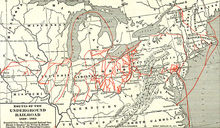 Harriet Tubman (photo H. B. Lindsley), c. 1870. A worker on the Underground Railroad, Tubman made 13 trips to the South, helping to free over 70 people.[1] the US Civil War |
|---|
| Northwest Ordinance |
| Kentucky and Virginia Resolutions |
| Missouri Compromise |
| Tariff of 1828 |
| Nullification Crisis |
| Nat Turner's slave rebellion |
| The Amistad |
| Texas Annexation |
| Mexican–American War |
| Wilmot Proviso |
| Ostend Manifesto |
| Manifest Destiny |
| Underground Railroad |
| Fugitive Slave Act of 1850 |
| Compromise of 1850 |
| Uncle Tom's Cabin |
| Kansas–Nebraska Act |
| Bleeding Kansas |
| Bleeding Sumner |
| Dred Scott v. Sandford |
| Brown's raid on Harper's Ferry |
| Election of 1860 |
| Secession of Southern States |
| Star of the West |
| Battle of Fort Sumter |
The Underground Railroad was an informal network of secret routes and safe houses used by 19th-century black slaves in the United States to escape to free states and Canada with the aid of abolitionists who were sympathetic to their cause.[2] The term is also applied to the abolitionists who aided the fugitives.[3] Other various routes led to Mexico or overseas.[4] Created in the early 19th century, the Underground Railroad was at its height between 1850 and 1860.[5] One estimate[5] suggests that by 1850, 100,000 slaves had escaped via the "Railroad". Canada was a popular destination with over 30,000 people arriving there to escape enslavement via the network at its peak,[6] though US Census figures only account for 6,000.[7] The Underground Railroad riders' stories are documented in The Underground Railroad Records.
Political background
Even at the height of the Underground Railroad, fewer than one thousand slaves from all slave-holding states were able to escape each year (just over 5,000 court cases for escaped slaves recorded), a quantity much smaller than the natural annual increase of the enslaved population. Though the economic impact was small, the psychological impact upon slaveholders of an informal network to assist escaped slaves was immense. Under the original Fugitive Slave Law of 1793, the responsibility for catching runaway slaves fell to officials of the states whence the slaves came, and the Underground Railroad thrived.
With heavy political lobbying, the Compromise of 1850, passed by Congress after the Mexican-American War, stipulated a more stringent Fugitive Slave Law. Ostensibly, the compromise redressed all regional problems. However, it coerced officials of free states to assist slave catchers if there were runaway slaves in the area, and granted slave catchers national immunity when in free states to do their job.[8] Additionally, free blacks of the North could easily be forced into slavery, whether they had been freed earlier or had never been slaves.[9] Suspected slaves were unable to defend themselves in court, and it was difficult to prove a free status. In a de facto bribe,[10] judges were paid more ($10) for a decision that forced a suspected slave back into slavery than for a decision that the suspected slave was in fact free ($5). Thus, many Northerners who would have otherwise been able and content to ignore far-away regional slavery chafed under nationally-sanctioned slavery, leading to one of the primary grievances of the Union cause by the Civil War's outbreak.[11]
Structure
Route
Many people associated with the Underground Railroad only knew their part of the operation and not of the whole scheme.
The resting spots where the runaways could sleep and eat were given the code names "stations" and "depots" which were held by "station masters". There were also those known as "stockholders" who gave money or supplies for assistance. There were the "conductors" who ultimately moved the runaways from station to station. The "conductor" would sometimes act as if he or she were a slave and enter a plantation. Once a part of a plantation the "conductor" would direct the fugitives to the North. During the night the slaves would move, traveling about 10–20 miles (15–30 km) per night. They would stop at the so-called "stations" or "depots" during the day and rest. While resting at one station, a message was sent to the next station to let the station master know the runaways were on their way. Sometimes boats or trains would be used for transportation.[13]
Traveling conditions
Although the fugitives sometimes traveled on real railways, the primary means of transportation were on foot or by wagon.
In addition, routes were often purposely indirect in order to throw off pursuers. Most escapes were by individuals or small groups; occasionally, such as with the Pearl incident, there were mass escapes. The journey was often seen as too arduous and treacherous for women or children to complete.
Due to the risk of discovery, information about routes and safe havens was passed along by word of mouth. Southern newspapers of the day were often filled with pages of notices soliciting information about escaped slaves and offering sizable rewards for their capture and return. Federal marshals and professional bounty hunters known as slave catchers pursued fugitives as far as the Canadian border.[14]
The risk was not limited solely to actual fugitives. Because strong, healthy blacks in their prime working and reproductive years were highly valuable commodities, it was not unusual for free blacks – both freedmen (former slaves) and those who had lived their entire lives in freedom – to be kidnapped and sold into slavery. "Certificates of freedom" – signed, notarized statements attesting to the free status of individual blacks – could easily be destroyed, and thus afforded their owners little protection. Moreover, under the terms of the Fugitive Slave Law of 1850, when suspected fugitives were seized and brought to a special magistrate known as a commissioner, they had no right to a jury trial and could not testify in their own behalf, since technically they were guilty of no crime. The marshal or private slave-catcher only needed to swear an oath to acquire a writ of replevin, for the return of property.
Nevertheless, Congress believed the fugitive slave laws were necessary because of the lack of cooperation by the police, courts, and public outside of the Deep South. States such as Michigan passed laws interfering with the federal bounty system, which politicians from the South felt was grossly inadequate, and this became a key motivation for secession.[citation needed] In some parts of the North slave-catchers needed police protection to carry out their federal authority. Despite their resistance to pro-slavery laws several states still made blacks unwelcome. Indiana went as far as to pass a constitutional amendment that barred blacks from settling in that state.
Terminology
Members of The Underground Railroad often used specific jargon, based on the metaphor of the railway. For example:
- People who helped slaves find the railroad were "agents" (or "shepherds")
- Guides were known as "conductors"
- Hiding places were "stations"
- Abolitionists would fix the "tracks"
- "Stationmasters" hid slaves in their homes
- Escaped slaves were referred to as "passengers" or "cargo"
- Slaves would obtain a "ticket."
- Just as in common gospel lore, the "wheels would keep on turning"
- Financial benefactors of the Railroad were known as "stockholders".[15]
The Big Dipper asterism (whose "bowl" points to the North Star) was known as the drinkin' gourd. The Railroad itself was often known as the "freedom train" or "Gospel train," which headed towards "Heaven" or "the Promised Land," i.e., Canada.
William Still,[16] often called "The Father of the Underground Railroad", helped hundreds of slaves to escape (as many as 60 a month), sometimes hiding them in his Philadelphia home. He kept careful records, including short biographies of the people, that contained frequent railway metaphors. He maintained correspondence with many of them, often acting as a middleman in communications between escaped slaves and those left behind. He then published these accounts in the book The Underground Railroad in 1872.
According to Still, messages were often encoded so that messages could only be understood by those active in the railroad. For example, the following message, "I have sent via at two o'clock four large hams and two small hams", indicated that four adults and two children were sent by train from Harrisburg to Philadelphia. However, the additional word via indicated that the "passengers" were not sent on the usual train, but rather via Reading, Pennsylvania. In this case, authorities were tricked into going to the regular train station in an attempt to intercept the runaways, while Still was able to meet them at the correct station and guide them to safety, where they eventually escaped either to the North or to Canada where slavery was abolished during the 1830s.
Folklore
The quilt design theory is disputed. The first published work documenting an oral history source was in 1999 and the first publishing is believed to be a 1980 children's book,[18] so it is difficult to evaluate the veracity of these claims, which are not accepted by quilt historians or scholars of antebellum America.[citation needed] There is no contemporary evidence of any sort of quilt code, and quilt historians such as Pat Cummings and Barbara Brackman have raised serious questions about the idea. In addition, Underground Railroad historian Giles Wright has published a pamphlet debunking the quilt code.
The Underground Railroad did spur cultural works, though. For example, a song written in 1860 about a man fleeing slavery in Tennessee by escaping to Canada, entitled Song of the Free, was composed to the tune of Oh! Susanna. Every stanza ends with a reference to Canada as the land "where colored men are free". Slavery in Canada had been in rapid decline after an 1803 court ruling, and abolished outright in 1834.
Legal and political
When frictions between North and South culminated in the American Civil War, many blacks, slave and free, fought with the Union Army. Following passage of the Thirteenth Amendment, in some cases the Underground Railroad operated in reverse as fugitives returned to the United States.[citation needed]
Arrival in Canada

Estimates vary widely, but at least 30,000 slaves, some say more than 100,000, escaped to Canada via the Underground Railroad.[6] The largest group settled in Upper Canada (called Canada West from 1841,[20] and today Southern Ontario), where numerous Black Canadian communities developed. These were generally in the triangular region bounded by Toronto, Niagara Falls, and Windsor. Nearly 1,000 refugees settled in Toronto, and several rural villages made up mostly of ex-slaves were established in Kent County and Essex County.
Another important center of population was Nova Scotia, for example Africville and other villages near Halifax, see Black Nova Scotians. Important black settlements also developed in other parts of British North America (now parts of Canada). These included Lower Canada (present-day Quebec) and Vancouver Island, where Governor James Douglas encouraged black immigration because of his opposition to slavery and because he hoped a significant black community would form a bulwark against those who wished to unite the island with the United States.
Upon arriving at their destinations, many fugitives were disappointed. While the British colonies had no slavery after 1834, discrimination was still common. Many of the new arrivals had great difficulty finding jobs, in part because of mass European immigration at the time, and overt racism was common. For example, the charter of the city of Saint John, New Brunswick was amended in 1785 specifically to exclude blacks from practicing a trade, selling goods, fishing in the harbour, or becoming freemen; these provisions stood until 1870.[21]
With the outbreak of the Civil War in the U. S., many black refugees enlisted in the Union Army and, while some later returned to Canada, many remained in the United States. Thousands of others returned to the American South after the war ended. The desire to reconnect with friends and family was strong, and most were hopeful about the changes emancipation and Reconstruction would bring.
This article is copied from an article on Wikipedia® - the free encyclopedia created and edited by online user community. The text was not checked or edited by anyone on our staff. Although the vast majority of the Wikipedia® encyclopedia articles provide accurate and timely information please do not assume the accuracy of any particular article. This article is distributed under the terms of GNU Free Documentation License.
Thanks to Encyclopedia The Free Dictionary / Farlex, Inc.
http://encyclopedia.thefreedictionary.com/p/Underground%20Railroad
| To Get Uninterrupted Daily Article(s) / Review(s) Updates; Kindly Subscribe To This BlogSpot:- http://Ziaullahkhan.BlogSpot.com Via "RSS Feed" Or "Email Subscription". | |
| BlogSpot | |
| Other Sites Related To This Blog; Kindly Visit: | |
| Amazon Books | |
| Amazon Magazines | |
| Kindle Store | |
| Products | |

No comments:
Post a Comment